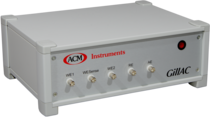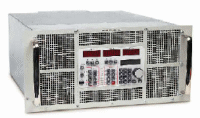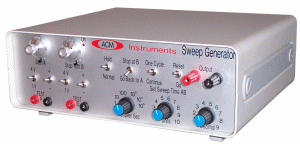Single Channel Instruments
Gill AC
 The Gill AC is our most popular instrument. This single channel instrument is an automated Potentiostat, Galvanostat and Zero Resistance Ammeter with integral Frequency Response Analyser and Sweep Generator in one neat enclosure. Allowing electrochemistry techniques such as EIS, LPR and current and voltage noise. The versatility of this instrument is then demonstrated with a number of options offering high power, low current and high speed sweep versions to name a few, allowing you to easily customise your instrument to meet the needs of your application. For more information click here.
The Gill AC is our most popular instrument. This single channel instrument is an automated Potentiostat, Galvanostat and Zero Resistance Ammeter with integral Frequency Response Analyser and Sweep Generator in one neat enclosure. Allowing electrochemistry techniques such as EIS, LPR and current and voltage noise. The versatility of this instrument is then demonstrated with a number of options offering high power, low current and high speed sweep versions to name a few, allowing you to easily customise your instrument to meet the needs of your application. For more information click here.
NEW INSTRUMENTS!
The Cage - A Gill AC built into an integrated Faraday cage. For more information click here.
Anode 16 - This instrument is used to determine the potential and current carrying capacity of alloys used for cathodic protection. It provides an easily used and reliable method of screening batches of sacrificial anodes to ensure performance consistency for batch to batch. For more information click here.
Zed 16 - This instrument features 16 zero resistance ammeters and is used to measure current flowing between two working electrodes for each channel. Each channel can also have a high impedance reference electrode input for measuring the potential of the couple. For more information click here.
0.1Hz Coulometry
_mid.png) The ideal method for monitoring pitting, crevice and other localised corrosion on passive metals such as stainless steel. For more information click here.
The ideal method for monitoring pitting, crevice and other localised corrosion on passive metals such as stainless steel. For more information click here.
Multiple Channel Instruments
Gill 6 / 8 / 12
 A cheaper method of increasing the number of channels is to add additional sequential channels. The software enables the operator to treat these sequential channels as independent and manages the channels in a time efficient manner. For more information click here.
A cheaper method of increasing the number of channels is to add additional sequential channels. The software enables the operator to treat these sequential channels as independent and manages the channels in a time efficient manner. For more information click here.
Weld Tester
 Welds pose a particular problem. Each weld is a complex galvanic couple made up of parent metal (e.g. a pipeline) a weld metal and an area of heat affected metal. This instrument is a Gill 6, 8 or 12 built to accommodate the extra four working electrodes per cell. Once the cell is connected the full range of DC and AC tests are used to determine the susceptibility of each component to corrosion. For more information click here.
Welds pose a particular problem. Each weld is a complex galvanic couple made up of parent metal (e.g. a pipeline) a weld metal and an area of heat affected metal. This instrument is a Gill 6, 8 or 12 built to accommodate the extra four working electrodes per cell. Once the cell is connected the full range of DC and AC tests are used to determine the susceptibility of each component to corrosion. For more information click here.
Simultaneous Multiple Channel Instruments
GalvoGill 12
 The GalvoGill 12 avoids the problems generated by multiplex units when performing long term tests. 12 Zero Resistance Ammeters (ZRA's) constantly monitor 12 pairs of electrodes to record the current flow with time. There are no switching currents as in a multiplexed system. Each pair may also have a reference electrode which is fully buffered and recorded. For more information click here.
The GalvoGill 12 avoids the problems generated by multiplex units when performing long term tests. 12 Zero Resistance Ammeters (ZRA's) constantly monitor 12 pairs of electrodes to record the current flow with time. There are no switching currents as in a multiplexed system. Each pair may also have a reference electrode which is fully buffered and recorded. For more information click here.
Isolated 20 & 30
.jpg) The Isolated 20 & 30 allows for individual pairs of working electrodes, with reference electrode, to be used in a common electrolyte without stray galvanic coupling between the pairs. The galvanic couples are maintained by 20 or 30 individual ZRA's, each galvanically isolated from the others unlike the GalvoGill 12 in which each pair is referenced to instrument ground (never mains ground in one of our instruments). For more information click here.
The Isolated 20 & 30 allows for individual pairs of working electrodes, with reference electrode, to be used in a common electrolyte without stray galvanic coupling between the pairs. The galvanic couples are maintained by 20 or 30 individual ZRA's, each galvanically isolated from the others unlike the GalvoGill 12 in which each pair is referenced to instrument ground (never mains ground in one of our instruments). For more information click here.
Parallel 30 LPR
The Parallel 30 LPR comprises thirty channels, two or three electrode. Each channel has a dedicated potentiostat and a four range ZRA for the determination of corrosion rate using LPR. The cells can be two or three electrode, when in three electrode mode the software allows for the LPR test to be performed at the rest potential.
A very useful and cost effective instrument for multiple LPR testing, 30 channels around 30 different rest potentials in parallel is unique. For more information click here.
Bi-Stat
 Two individual and isolated Gill AC Instruments housed in the same enclosure that can be run independently, even in the same cell. Each instrument offers a Potentiostat, Galvanostat and Zero Resistance Ammeter with integrated Frequency Response Analyser and Sweep Generator in one. This allows for a wide range of Electrochemical tests to be peformed such as AC Impedance (EIS) and standard DC tests including LPR and current and voltage noise. For more information click here.
Two individual and isolated Gill AC Instruments housed in the same enclosure that can be run independently, even in the same cell. Each instrument offers a Potentiostat, Galvanostat and Zero Resistance Ammeter with integrated Frequency Response Analyser and Sweep Generator in one. This allows for a wide range of Electrochemical tests to be peformed such as AC Impedance (EIS) and standard DC tests including LPR and current and voltage noise. For more information click here.
Pot 16
singleswitch.png) The Pot 16 has 16 potentiostats built in, each at a fixed range i.e. not changed through the software. This allows very long tests of electrodes under potentiostatic control to be performed in complete certainty that the set potential will not be changed. Current and potential are recorded with time. Ideal for the study of cathodic disbondment. For more information click here.
The Pot 16 has 16 potentiostats built in, each at a fixed range i.e. not changed through the software. This allows very long tests of electrodes under potentiostatic control to be performed in complete certainty that the set potential will not be changed. Current and potential are recorded with time. Ideal for the study of cathodic disbondment. For more information click here.
Zed 16
.png) The Zed 16 instrument features 16 zero resistance ammeters and is used to measure current flowing between two working electrodes for each channel. Each channel can also have a high impedance reference electrode input for measuring the potential of the couple. For more information click here.
The Zed 16 instrument features 16 zero resistance ammeters and is used to measure current flowing between two working electrodes for each channel. Each channel can also have a high impedance reference electrode input for measuring the potential of the couple. For more information click here.
Gal 16
.png) The Gal 16 has 16 galvanostats built in, each at a fixed range i.e. not changed through the software. This allows very long tests of electrodes under galvanostatic control to be performed in complete certainty that the set current will not be changed. Current and potential are recorded with time. Ideal for the study of cathodic disbondment. For more information click here.
The Gal 16 has 16 galvanostats built in, each at a fixed range i.e. not changed through the software. This allows very long tests of electrodes under galvanostatic control to be performed in complete certainty that the set current will not be changed. Current and potential are recorded with time. Ideal for the study of cathodic disbondment. For more information click here.
Anode 16
.png) The Anode 16 is a new instrument from ACM Instruments. The instrument is used to determine the potential and current carrying capacity of alloys used for Cathodic Protection. It provides an easily used and reliable method of screening batches of sacrificial anodes to ensure performance consistency for batch to batch. Built to standards you require e.g DNV-RP-B401, NACE TM0190, NORSOK M-503, AS2239 and many more. Click here to view Anode 16 details
The Anode 16 is a new instrument from ACM Instruments. The instrument is used to determine the potential and current carrying capacity of alloys used for Cathodic Protection. It provides an easily used and reliable method of screening batches of sacrificial anodes to ensure performance consistency for batch to batch. Built to standards you require e.g DNV-RP-B401, NACE TM0190, NORSOK M-503, AS2239 and many more. Click here to view Anode 16 details
Parallel Systems
_mid.png)
There are two types of Parallel System.
- A Parallel System based around the Gill AC, Gill 12 or Weld Tester. This type of Parallel System allows individual sequential instruments to be used separately or to be coupled together using software to provide additional features and simultaneous testing.
- A standalone Parallel System thats designed for a specific task that allows simultaneous testing.
Our new Gill AC, Gill 12 and Weld Tester range of simultaneous multiple instruments are our most versatile to date. Each instrument can work individually or be coupled with other instruments. This allows added features such as high speed sweeps and multiple Gill AC's acting as a Weld Tester.
For more information on Parallel systems then please click here for more information
High Powered Instruments
Battery Engine
It is possible to increase either the potential or current range of all our laboratory instrumentation. A external 'buffer box' or  power supply can be used in conjunction with our instruments, which helps keep the versatility of the standard instrument. An example of such an instrument is the Battery Engine. For more information click here.
power supply can be used in conjunction with our instruments, which helps keep the versatility of the standard instrument. An example of such an instrument is the Battery Engine. For more information click here.
For a bespoke high powered instrument please contact us.
Manual Instrumentation

